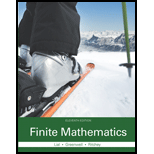
Set up and solve Exercises 23–29 by the simplex method.
APPLY IT Manufacturing Bicycles A manufacturer of bicycles builds racing, touring, and mountain models. The bicycles are made of both steel and aluminum. The company has available 91,800 units of steel and 42,000 units of aluminum. The racing, touring, and mountain models need 17, 27, and 34 units of steel, and 12, 21, and 15 units of aluminum, respectively. (See Exercise 28 in Section 4.1.)
(a) How many of each type of should be made in order to maximize profit if the company makes $8 per racing bike, $12 per touring bike, and $22 per mountain bike?
(b) What is the maximum possible profit?
(c) Does it require all of the available units of steel and aluminum to build the bicycles that produce the maximum profit? If not, how much of each material is left over? Compare any leftover to the value of the relevant slack variable.
(d) There are many unstated assumptions in the problem given above. Even if the mathematical solution is to make only one or two types of the bicycles, there may be demand for the type(s) not being made, which would create problems for the company. Discuss this and other difficulties that would arise in real situation.
Trending nowThis is a popular solution!

Chapter 4 Solutions
Finite Mathematics (11th Edition)
Additional Math Textbook Solutions
Elementary Statistics ( 3rd International Edition ) Isbn:9781260092561
Pathways To Math Literacy (looseleaf)
Finite Mathematics for Business, Economics, Life Sciences and Social Sciences
College Algebra (Collegiate Math)
Precalculus
Intermediate Algebra (13th Edition)
- Q1: A slider in a machine moves along a fixed straight rod. Its distance x cm along the rod is given below for various values of the time. Find the velocity and acceleration of the slider when t = 0.3 seconds. t(seconds) x(cm) 0 0.1 0.2 0.3 0.4 0.5 0.6 30.13 31.62 32.87 33.64 33.95 33.81 33.24 Q2: Using the Runge-Kutta method of fourth order, solve for y atr = 1.2, From dy_2xy +et = dx x²+xc* Take h=0.2. given x = 1, y = 0 Q3:Approximate the solution of the following equation using finite difference method. ly -(1-y= y = x), y(1) = 2 and y(3) = −1 On the interval (1≤x≤3).(taking h=0.5).arrow_forwardФ sketch stability x= -4x + 2xy - 8 y° = 4 y 2 - x² чуг.arrow_forward2 Q/Given H (x,y) = x² + y² - y² Find the Hamiltonian System and prove it is first integral-arrow_forward
- Q2) A: Find the region where ODEs has no limit cycle: x = y + x³ y=x+y+y³ 6arrow_forwardQ3)A: Given H(x,y)=x2-x+ y²as a first integral of an ODEs, find this ODES corresponding to H(x,y) and show the phase portrait by using Hartman theorem and by drawing graph of H(x,y)-e. Discuss the stability of critical points of the corresponding ODEs.arrow_forwardQ/ Write Example is First integral but not Conservation system.arrow_forward
- Algebra & Trigonometry with Analytic GeometryAlgebraISBN:9781133382119Author:SwokowskiPublisher:Cengage
 Algebra for College StudentsAlgebraISBN:9781285195780Author:Jerome E. Kaufmann, Karen L. SchwittersPublisher:Cengage Learning
Algebra for College StudentsAlgebraISBN:9781285195780Author:Jerome E. Kaufmann, Karen L. SchwittersPublisher:Cengage Learning

